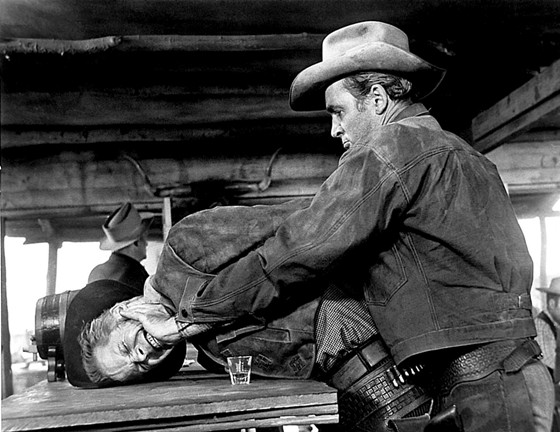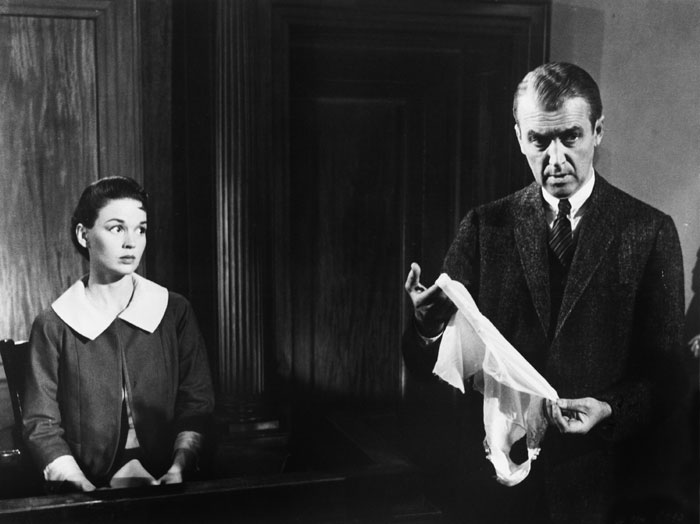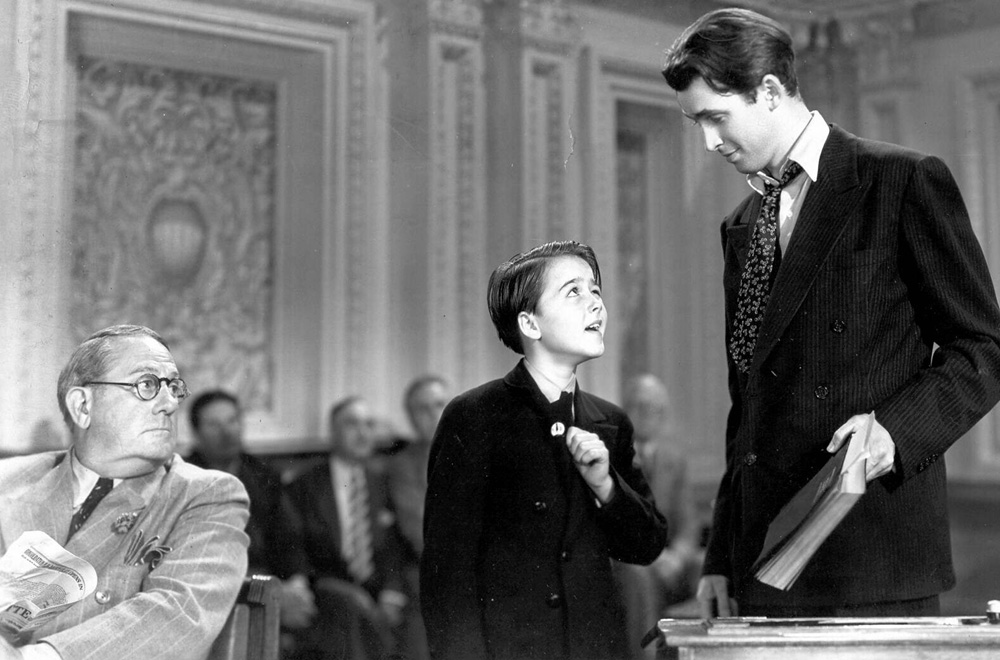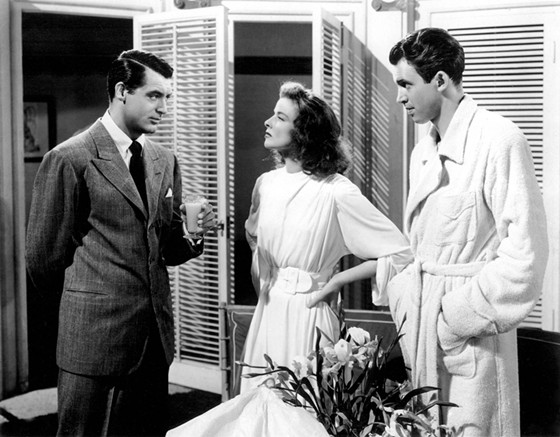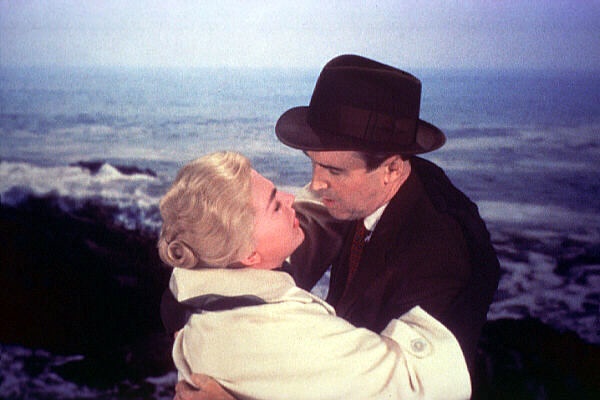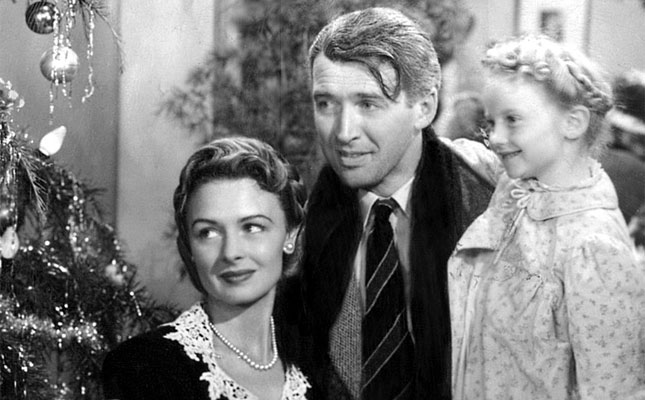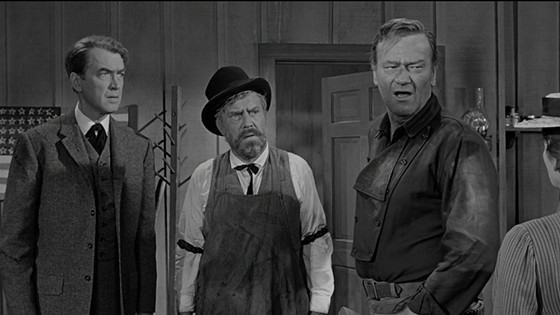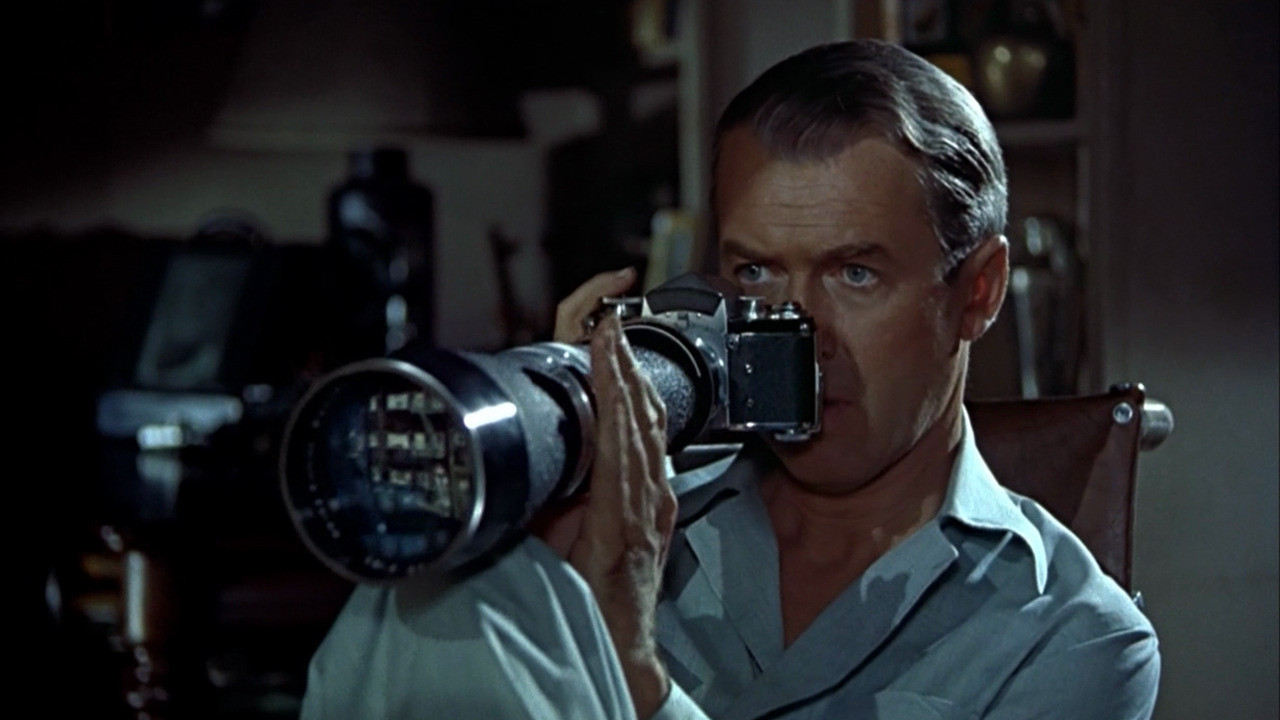8. Winchester ’73 (1950)
The first and best of the Anthony Mann westerns is Winchester ’73, the film that helped Stewart rewrite and update his image for the new decade ahead. Stewart is Lin McAdam who, along with friend ‘High-Spade’ Wilson is chasing outlaw ‘Dutch Henry’ Brown (Stephen McNally). After chasing Brown to Dodge City, Lin and the bad guy compete for a prized Winchester rifle in a shooting match, which Lin wins. Brown jumps Lin afterwards at his boarding house and steals the prize rifle and the chase is on, with saloon hall girl Lola (Shelly Winters) along for the ride. In one of the most memorable scenes in the film, Lin showed his dark side when he assaults Waco (Dan Duryea) in a barroom and brutally tortures him until he tells him the whereabouts of Brown.
A tough, gritty western, Winchester ’73 established Stewart as one of the premiere western actors as Hollywood headed into the 1950’s, the greatest decade for that genre.
7. Anatomy of a Murder (1959)
As the decade of the 1950’s came to a close, Stewart again updated his image as a cool, tough lawyer in Otto Preminger’s film Anatomy of a Murder. Stewart plays Paul Biegler, a small town lawyer hired to defend Manny Manion (Ben Gazarra) who has killed innkeeper Barney Quill. Manion admits to the deed, but says that he was enraged that Quill had raped his attractive wife Laura (Lee Remick) and that he blacked out and has no memory of the event. Opposing Biegler on the prosecution side is big city lawyer Claude Dancer, played by George C. Scott.
The film is a riveting courtroom drama, as Stewart’s small town lawyer must rely on all his skills to defend Manion given the weight of evidence against his client, and to persuade the jury that Manion must be found innocent based on his psychological condition. Stewart entered into the later phase of his career with this film, bringing substantial gravitas to the part based on the lengthy and successful career that he had already enjoyed.
6. Mr. Smith Goes to Washington (1939)
Stewart’s great early success for Frank Capra was this part, which he stepped into when Gary Cooper was unavailable. Stewart is Jefferson Smith, head of the Boy Rangers, who is unexpectedly appointed U.S. Senator when the incumbent dies. In Washington, he is at first befriended by his fellow Senator Paine (Claude Rains) who then turns on Smith when he proposes a bill to set aside some land in his home state for a national boy’s camp.
Paine is under the thumb of boss Jim Taylor (Edward Arnold) and the boy’s camp would ruin a dam building graft scheme that Taylor has planned. Urged on by his secretary, Saunders (Jean Arthur) Smith attempts a 24 hour filibuster to avoid expulsion by the Senate. Mr. Smith Goes to Washington features a dramatic, patriotic story and Stewart was the perfect actor to convey Smith’s naiveté and idealistic belief in the democratic system.
5. The Philadelphia Story (1940)
After establishing himself as a star in the late ’30’s, Stewart jumped into this film as McCauley “Mike” Connor, a tabloid reporter sent to the home of socialite Tracy Lord (Katherine Hepburn) to cover Tracy’s marriage to the nouveau riche George Kittredge. Complicating matters is the presence of Tracy’s ex-husband, C.K. Dexter Haven (Cary Grant), a wealthy alcoholic who could not live up to Tracy’s high standards despite the fact that everyone else in the family likes him. After a night of wild drinking and partying, Mike and Tracy end up by the family pool apparently falling in love, complicating the upcoming nuptials considerably.
Directed by George Cukor, this ‘comedy of re-marriage’ film became one of Hollywood’s great classics, and established Stewart as a force to be reckoned with even aside heavyweights Hepburn and Grant. Furthermore, Jimmy won the Academy Award for best actor for the film.
4. Vertigo (1958)
Stewart was perhaps a bit too old to be convincing in this film, now considered one of Alfred Hitchcock’s greatest achievements. He plays Scotty Ferguson, a police detective who retires after a colleague falls trying to rescue him. Coaxed out of retirement by Gavin Elster (Tom Helmore) to watch his wife, Madeleine (Kim Novak) who appears to be acting under the influence of a dead relative, Scotty falls in love with Madeleine despite the intervention of his longtime friend Midge (Barbara Bel Geddes). When Madeleine appears to kill herself by leaping from a mission tower, Scotty loses his mind, only to later encounter Judy Barton (Novak) whom he attempts to remake into his lost love.
Stewart handled the challenging part of Scotty, a man torn between reality and his obsession with recapturing the past, with his usual professionalism. The film was a box office disappointment, though, on its initial release, and Hitchcock and Stewart never worked together again. Vertigo has seen its critical fortunes rise considerably and is now considered one of, if not the greatest film of all time.
3. It’s a Wonderful Life (1946)
Another film that failed to ignite at the box office but saw its fortunes rise over time is It’s a Wonderful Life, the first film that Stewart made after returning from the war. Reunited with director Frank Capra, Stewart is George Bailey, who takes over the building & loan in small town Bedford Falls from his father. After seeing friends and relatives go off into the world and become successful while he stays behind, Bailey has a crisis on Christmas Eve when his Uncle Billy (Thomas Mitchell) loses $8,000 of the building & loan’s money. Persecuted by the greedy Mr. Potter (Lionel Barrymore) and beyond the help of sympathetic wife Mary (Donna Reed), George must be visited by an angel, Clarence (Henry Darrow) when he contemplates killing himself and wonders what the world would have been like had he never been born.
Capra’s career never recovered from the film’s failure and Stewart had several more stumbles before reestablishing his career in the 1950’s. Finding an audience after repeated showings on television, the film has become a Christmas favorite that now is beloved by millions.
2. The Man Who Shot Liberty Valance (1962)
Director John Ford made an art form of the western, and he pared Stewart with equally iconic John Wayne in this ‘noir’ western about the importance of myths and legend. Ransom Stoddard (Stewart) comes to the west an idealistic lawyer, but he encounters the brutal Liberty Valance (Lee Marvin) who meets out justice with a gun and a whip, not a law book. Taken in by Hallie (Vera Miles) and her family, Stoddard meets Tom Doniphan (John Wayne), Hallie’s suitor, who confirms to Stoddard what Liberty Valance had told him: in the west the rule of law is decided by gun and fists, not books.
Against the backdrop of potential statehood, Ransom Stoddard must overcome his fears – with or without the help of his friend, Doniphon – and face his final showdown with the bully Valance on the streets of Shinebone. Stewart would later make several low key westerns such as Shenandoah and The Cheyenne Social Club that garnered fans, but he would not again make a western with the brilliant themes and magnificent performances of The Man Who Shot Liberty Valance, one of filmdom’s all time classics.
1. Rear Window (1954)
“Aw, we’ve become a race of peeping toms. What people ought to do is get outside of their houses and look IN for a change!” Thus speaks Stella (Thelma Ritter), insurance company nurse to L.B. Jeffries (Stewart) a photographer who has broken his leg taking a picture and now sits wearing a cast in his Greenwich Village apartment, watching the neighbors. Jeffries comes to suspect neighbor Lars Thorwald (Raymond Burr) of killing his invalid wife and he final convinces girlfriend Lisa (Grace Kelly) of this, despite the skepticism of old army buddy and police detective Doyle (Wendell Corey).
Rear Window is one of director Alfred Hitchcock’s best known and most beloved films, not just for the suspense and drama that the characters encounter but for the deep meditation on life and the dangers of living vicariously through others. Rear Window was the peak of the collaboration that Stewart had with Hitchcock in the 1950’s, a major hit with audiences and a nominee for best picture of the year. After being unavailable to audiences throughout the 1970’s, Rear Window was re-released to acclaim in 1983, restored fully and re-released again in 1999 and is now available on blu-ray as part of Universal’s Alfred Hitchcock collection. See it…and see it often!
Author Bio: Jim Davidson is a 1980 graduate of Northwestern University’s Radio-TV-Film Dept. He lives in the San Francisco Bay Area and has been a video producer since 1987. Jim has written articles for Images Film journal and is currently working on a book about the movie Harold and Maude.
